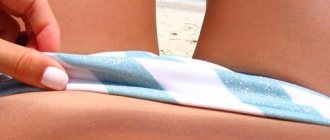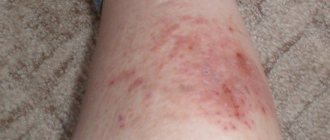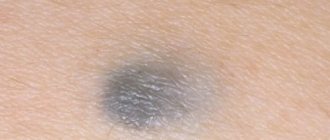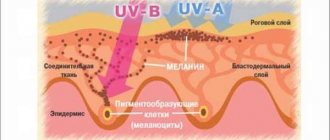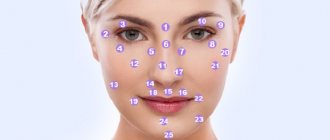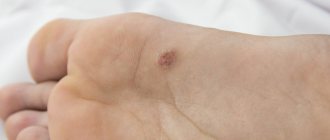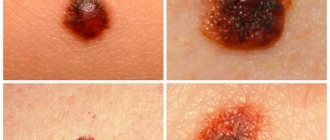The most common reasons for removing moles on the body and face are medical indications (doctor's prescription), discomfort when in contact with clothing and accessories, or the aesthetic choice of the patient.
mediSPA BIOSFERA employs dermatocosmetologists whose extensive experience helps painlessly and safely remove unwanted moles, regardless of the cause. ⠀ Before removing nevi, a non-contact examination is carried out with a dermatoscope, which allows you to enlarge the image of the skin formation tens of times and draw a conclusion about the degree of its safety.
Reasons for appearance on the face
Moles appear on the face due to a large accumulation of melanocyte cells between the dermis (lower layer) and epidermis (upper layer). They look like growths coming out. Markings on the face are of the following types:
- Hemangiomas are vascular formations in nature, appearing in the upper layers of the skin in the form of hanging nevi, red in color, and small in size.
- Flat growths occur on the epidermis, spread throughout the body, react poorly to ultraviolet rays and do not grow in large quantities.
- Convex moles grow from the dermis and are knobby or smooth in type. They are small in size with growing hair.
- Blue formations appear in the upper layer of the skin and have different colors (from light to dark tones) and size. They have a dense, smooth structure.
- Large birthmarks are often congenital in nature and grow with the wearer. The spots are grayish or brownish in color and may turn black over time.
Neoplasms on the face appear for the following reasons:
- hereditary factor. Most moles on the body are passed on from parents to children. They are located in the same place, have the same shape;
- rapid development of blood capillaries;
- hormonal imbalances under the influence of pregnancy, puberty in adolescents and menopause in women. Taking hormonal drugs affects the growth of nevi;
- injury to formations causes the growth of nevi. A regenerative mechanism is launched, enhanced by the production of dermis and melanocytes. An accumulation of a large number of melanocytes in one place appears as a mole;
- ultraviolet radiation affects the growth of formations. Abuse of tanning or prolonged exposure to the sun, frequent visits to the solarium affect the growth of new nevi, changes in size and color of old ones. They turn black or white when exposed to sunlight;
- viral or bacterial infections;
- X-ray or radiation exposure.
Knowing what type and under the influence of what factor moles appeared on the face, you can begin to remove them and prevent further appearance. In rare cases, depigmentation of the formation is observed.
Indications for removal of nevi
If a mole does not pose a health hazard, it is not recommended to remove it. The growths are removed in the following cases:
- the mole continues to grow and becomes noticeably larger;
- the outlines of the neoplasm lose their clarity and become uneven;
- the color of the growth changes;
- a convex nevus becomes asymmetrical and spreads across the skin;
- peeling, cracks, inflammation, and suppuration appeared on the surface of the mole;
- the tumor began to bleed.
The listed complications are a serious reason to immediately visit a doctor.
Another justified reason to get rid of a mole is the high probability that the nevus will be injured . Usually, growths that arise in areas of increased friction or pressure are damaged - in the groin area, armpits, collar area, and waist.
Open formations that appear on the hands or face are often injured. Damaged birthmarks lead to life-threatening consequences, so they must be eliminated.
Neoplasms are removed if they are located in such a way that they interfere with the functioning of other organs. For example, a hanging nevus on the eyelid makes it difficult to see. After the examination, the growth is removed in a medical facility.
What does it mean for men and women
The meaning differs by gender. Each nevus on the face carries a hidden meaning or character trait of the wearer.
| On the face of men | On women's faces |
| A nevus on the right side of the forehead speaks of fame and prosperity. | The sign located in the area of the “third eye” talks about a passion for mysticism and developed intuition. |
| A mark near the ear signifies a cheerful and careless character. | A mole in the nose area indicates a passion for travel. |
| A nevus on the chin indicates respect from others. | A formation under the lower eyelid means that the owner is leading a stormy married life. |
| Elements in the lower part of the cheek indicate frivolity and poor health. | The mark under the left eye signifies a subtle, poetic nature. |
| The mark located near the right eye on the inside speaks of the man as a wonderful father and monogamous man. | A nevus on the right eye in the angular part indicates jealousy and irritability of character. |
| Lust is marked by a mole in the corner of the mouth. | A mole at the bottom of the right eye speaks of generosity, devotion, and sensitivity. |
| A nevus located in the temporal zone indicates a firm nature and a conservative outlook on life. | The mark on the left side of the eye indicates the frivolity and changeability of nature. |
| A mark in the outer corner of the eye signifies a romantic personality. | Sexuality is marked in the left corner area of the mouth. |
| Education on the nose indicates a careerist. | A greenish mole under the eyebrow on the left side indicates a rich, happy marriage. |
| A nevus located under the ear in the neck area speaks of determination and a high level of intelligence. | A mole on the left cheek means excessive attention from the opposite sex. |
What to do if the histology is bad
Poor histology of moles after removal is not a final diagnosis or verdict. The correct diagnosis will be made by an oncologist based on the following factors:
- age, gender;
- visual inspection results;
- tissue histopathology;
- individual, family history of the patient;
- history of skin cancer;
- data from other examination methods.
During a histological examination, the presence of a malignant process, the type of carcinoma, and its degree are determined. Based on these data, the doctor chooses patient management tactics and develops a treatment plan.
Symptoms of malignancy
By nature, formations on the body are benign, but under the influence of various factors, transformation into melanoma is possible. It is important to examine your body regularly, and if you notice the slightest changes, get examined by an oncologist or dermatologist. When skin cancer develops, the following symptoms will occur:
- a mole on the face began to grow and increase in size in a short time, changed color and structure;
- if the growth begins to itch, there is a burning sensation, an increase in itching;
- the nevus and the areas around it began to peel off;
- inflammation of the mole, the skin around it is swollen and red;
- the presence of cracks from which blood oozes;
- pain when touched;
- discoloration of the nevus and skin around it to black.
If at least one warning sign of a mole turning into a malignant tumor occurs, you should immediately visit a doctor. Timely treatment will help avoid serious consequences.
Why do they become convex?
Most moles form on the human body during early childhood and adolescence; the skin of newborns is devoid of such marks. The only exceptions are some types of nevi.
The fact that moles have become convex, more noticeable, and there is also a transition from one color to another may be a sign that the existing spot has degenerated into a malignant form.
The appearance of protruding, that is, convex moles, can be caused by a number of the following main factors:
- Hormonal imbalance, which is more often observed during puberty, menopause, and also during pregnancy.
- Nevi located on exposed areas of the body may change color and slowly enlarge due to exposure to ultraviolet radiation. As a rule, an increase in birthmarks on the neck, face, and arms occurs more often.
- Diseases of the endocrine system, digestive tract.
- Age-related tissue changes. Convex moles appear especially often in older people, due to typical tissue changes caused by age.
It should be noted that degeneration of a convex mark is observed extremely rarely; therefore, in the absence of such signs, there is no need to remove such a neoplasm.
Safe removal methods
Indications for removal of a growth on the head in the facial area are the possibility of degeneration into cancer, frequent damage and cosmetic defects. There are marks on the face that cause inconvenience and cannot be cosmetically disguised. They are dangerous - a man can injure the formation when shaving, which is fraught with inflammatory processes and the risk of degeneration. The use of low-quality cosmetics leads to skin irritation, which negatively affects the mole.
Formations that are benign, single and of small size can be removed using pharmaceutical preparations, after carefully reading the instructions, at home.
But this method does not always lead to the desired result. To safely eliminate nevi, papillomas and warts, modern medicine provides the following methods:
Cryodestruction
Removal of moles from the face occurs by freezing with liquid nitrogen. In case of superficial formation, apply a cotton pad soaked in liquid nitrogen for three minutes. This action leads to numbness and death of the nevus. For deep nevi, a special device (cryodestructor) is used.
The procedure involves injecting liquid nitrogen under the skin using a thin needle. Getting rid of the growth is painful, and the rehabilitation period is about six months.
Laser
Laser therapy is a common technique for removing growths from the face. Excision does not take much time and does not leave scars or scars. The specialist can adjust the diameter of the beam and the depth of penetration into the skin, removing the formation from the roots. The rehabilitation period takes two weeks. The risk of relapse is minimal.
Electrocoagulation
You can get rid of moles using electric current. During the procedure, an alternating and direct current apparatus is used, using various forms of electrodes. Under the influence of current, the formation and the area around it are cauterized. A crust forms, which cannot be touched (it should fall off on its own). The rehabilitation period is 10 days. The disadvantage of this method is the risk of scarring.
Radio wave method
Using this method, removal will be painless and will not take much time. During the procedure, a radioknife is used, which acts non-contactly on the skin, removing layer by layer of the formation. Does not leave scars or scars. Histology of the biomaterial can be performed.
Surgery
Removing lesions from the face by surgical method is not popular, but it has advantages:
- it is possible to conduct a study of biomaterial;
- the mole is completely removed, minimal risk of recurrence;
- affordable price;
- There are no absolute contraindications.
An experienced doctor will not leave any traces after the procedure in the form of scars or scars.
How tumors are removed
Removal of skin tumors is carried out using an EHF device, which “seals” the vessels feeding the mole) using local anesthesia. A high-frequency current is supplied to a thin metal loop - it cuts off the mole and coagulates (that is, “solders”) the vessels feeding the mole.
Heating of the tissues of the mole occurs in seconds, the device acts on the desired area locally, without touching healthy skin. This avoids bleeding and damage around the point of impact. Due to the fact that the working loop is thin and has a small diameter, it is possible to work even with small papillomas or nevi.
How to avoid scars and scars
After excision of a mole, it is important not to tear off the formed crust. It will dry out and fall off on its own. This will help avoid infection, an inflammatory process that causes suppuration, and scar formation. Proper care of the postoperative wound will help avoid this. Processing instructions:
- regularly change dressings, avoiding touching the open wound;
- treating the wound with an antiseptic;
- You can use antibiotic ointment prescribed by your doctor;
- if there are indications, you can use ointments and gels for scars, but only for their intended purpose;
- to increase blood flow, you can massage the area around the removed nevus after removing the sutures or when the scab falls off;
- the recovery period will go faster if you eat foods high in vitamin A, C, omega 3 and 6 acids, and zinc;
- protect the wound from ultraviolet radiation.
Hypertrophic scar - mechanism and causes.
What is a scar? Any damage to the skin - a scratch or post-operative suture - always ends in tissue restoration. Under certain conditions, which are currently not fully known, the regeneration process is disrupted. Instead of normal cells, the body forms an excess number of fibroblasts at the site of injury. Our blood vessels, ligaments and tendons are made up of them and their descendants. The appearance of these cells in large quantities at the site of skin damage is expressed in the appearance of scars.
There are several known factors among the causes of scars:
- Large depth and area of skin damage
- Deficiency of ascorbic acid, oligoelements (silicon, cobalt, iron, copper, potassium, magnesium, calcium, zinc, selenium), oxygen
- Dysfunction of the endocrine system (thyroid, adrenal glands)
- Decreased general and local immunity
- Dysfunction of the regulatory functions of the central nervous system
Possible complications and precautions
Complications appear after poor-quality mole removal. They often occur after mixing at home. The consequences are:
- partial removal of the nevus leads to secondary growth;
- damage to healthy epithelium during the removal procedure;
- possible burns that require careful care;
- after the procedure, scars appear;
- infection and bleeding.
A serious complication is the transformation of a nevus into melanoma, followed by the growth of metastases affecting the lymphatic system and distant organs.
Treatment will be long and difficult, and death is possible. It is possible to prevent the consequences by adhering to proper care of formations on the body. You should inspect them regularly to monitor for changes. Protect your facial skin from the sun using special products.
Removal and treatment of moles with laser
After laser removal of a mole and to achieve the best cosmetic result until the wound heals, it is recommended to follow these recommendations:
- Avoid UV rays (and when unavoidable, use sunscreen with at least SPF 30, preferably SPF50). If the patient tans during healing, there is a high likelihood of post-inflammatory pigmentation, which can make the area where the procedure was performed more visible;
- Do not go to solariums, saunas, swimming pools, or engage in vigorous physical exercise (to avoid infections and injuries).
- As the wound heals, dry scabs form and act as a natural dressing to prevent infection. These scabs should not be scratched or otherwise torn off - wait until they fall off on their own.
During the procedures prescribed by the doctor - disinfection and dressing - the wound heals well and no infectious (or other complications) arise. Once the wound has healed, redness persists and sometimes it takes 1 to 2 months for the area of skin to reach its final appearance after the procedure. If the initial scabs have fallen off and there is an increased risk of scarring, a special scar treatment cream can be applied.
The main measures that are recommended for the treatment of scars formed after laser mole removal are as follows:
- Special purpose creams with silicone and so on.
- Special patches with silicone.
Silicone patch for scar treatment
